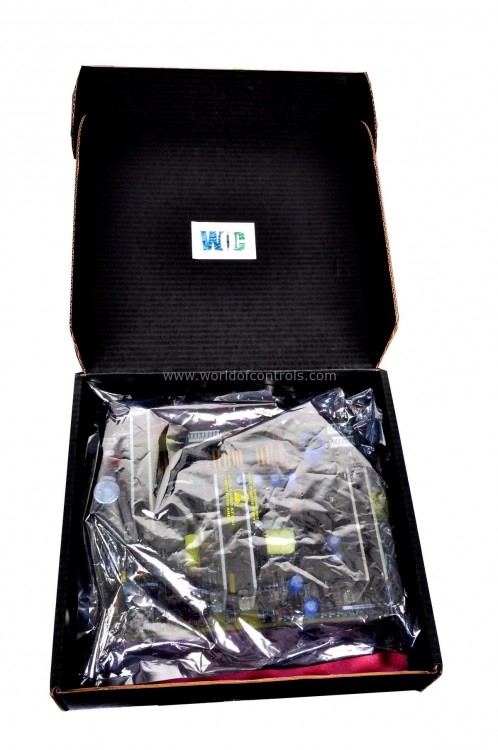SPECIFICATIONS
Part Number: DS200LSTQF1ACC
Manufacturer: General Electric
Series: Mark V
Product type: Software EPROM
Availability: In Stock
Country of Manufacture: United States (USA)
Functional Description
DS200LSTQF1ACC is a software EPROM designed and developed by GE. It is a part of the Mark V control system. EPROM stands for Erasable Programmable Read-Only Memory, representing a significant advancement in memory technology. The process of writing data onto an EPROM involves maintaining the storage cells within a specific initial state. This initial state must be preserved during the writing process to ensure accurate and reliable data storage. However, altering the stored information requires a specialized procedure involving exposure to ultraviolet (UV) light to erase the EPROM's contents, returning the storage cells to their default state for new data to be written.
Features
- Compared to PROM (Programmable Read-Only Memory), the storage permanency of EPROM is somewhat reduced due to its susceptibility and responsiveness to electrical noise and radiation. Factors such as environmental radiation or electrical interference can potentially alter the stored data in an EPROM, requiring careful handling and protection to maintain data integrity.
- MOS (Metal-Oxide-Semiconductor) transistors form a fundamental component in the construction of EPROM. These transistors serve as the basis for the memory cells within the EPROM chip. Each memory cell consists of a MOS transistor and a floating-gate capacitor. The charge stored in the floating-gate determines the state of the memory cell, representing the stored data as either a 0 or a 1.
- During the writing process, a voltage applied to the control gate of the MOS transistor allows electrons to tunnel through the insulating oxide layer, modifying the charge stored in the floating-gate and altering the cell's state. This ability to modify the charge on the floating-gate is what allows data to be written to the EPROM.
- Despite its susceptibility to external factors, the EPROM's unique optical read and write capabilities, driven by MOS transistor technology, have proven instrumental in various applications, offering a balance between programmability and stability in data storage within the realm of memory technology.
System Vibration Measurement and Protection
- Vibration Measurement and Protection are integral aspects of ensuring machinery reliability and performance. The Mark V system, renowned for its versatility and robustness, offers a comprehensive approach to handle various types of vibration sensors directly connected to it, facilitating efficient monitoring and protection.
- Three primary types of vibration sensors can be interfaced with the Mark V system:
- Seismic (Velocity) Inputs: These sensors measure velocity-based vibrations and provide critical data regarding the machinery's movement, allowing for analysis and monitoring of seismic activities affecting the equipment.
- Accelerometer Inputs: Accelerometers, used to gauge acceleration-based vibrations, offer insights into the equipment's dynamic behavior, aiding in the detection of anomalies or irregularities in machinery operation.
- Proximity Transducer Inputs: Proximity transducers encompass various inputs such as vibration, position, and key phasor inputs. They provide multifaceted data crucial for comprehensive analysis, including positional information and phase angle measurements of vibration signals.
- In Triple Modular Redundancy (TMR) systems, any discrepancies between the inputs from the three control processors trigger an internal diagnostic fault message. However, despite this discrepancy, the vibration protection system continues performing its calculations based on the median vibration signal, ensuring ongoing machinery protection.
- The Mark V system offers a user-friendly operator interface equipped with monitors displaying essential information. This includes 1X and unfiltered vibration levels, along with the 1X vibration phase angle, enabling operators to swiftly monitor and analyze machinery performance.
- Moreover, an optional module with buffered, BNC type connectors allows for remote monitoring using Bentley Nevada's specialized vibration analysis equipment, facilitating in-depth analysis and diagnostics.
- The system's customization features enable tailoring of control strategies for each site's specific requirements. For instance, multiple operator interfaces can interface with various systems, or multiple interfaces can communicate with a single Mark V unit. This hierarchical control programming ensures flexibility and adaptability in managing complex operational setups.
- The Mark V system also supports communication links to external systems like Distributed Control Systems (DCS) or remote computers via ModbusTM or EthernetTM TCP/IP protocols, utilizing GE Standard Messages as the application protocol. These communication links enable seamless integration with external systems for centralized monitoring, control, and data sharing, enhancing overall operational efficiency and ease of management.
WOC is available 24x7 to assist you with any of your General Electric requirements. Please contact us by phone or email for pricing and availability on GE, Bently Nevada or Woodward parts and repairs.
FREQUENTLY ASKED QUESTIONS
What is DS200LSTQF1ACC?
It is a Software EPROM designed and developed by GE
What types of vibration sensors can be connected to the Mark V system?
The Mark V system supports three primary types of vibration sensors: Seismic (Velocity) Inputs for monitoring velocity-based vibrations, Accelerometer Inputs to gauge acceleration-based vibrations, and Proximity Transducer Inputs offering multifaceted data including positional information and phase angle measurements.
How does the Mark V handle discrepancies in Triple Modular Redundancy (TMR) systems?
Discrepancies among inputs from the three control processors in TMR systems trigger internal diagnostic fault messages. However, the vibration protection system continues its calculations based on the median vibration signal, ensuring continuous machinery protection despite discrepancies.
What information does the operator interface display?
The Mark V operator interface features monitors displaying crucial information such as 1X and unfiltered vibration levels, as well as the 1X vibration phase angle. This data allows operators to efficiently monitor and analyze machinery performance.
Does the Mark V system support remote monitoring for in-depth analysis?
Yes, an optional module equipped with buffered, BNC type connectors enables remote monitoring using Bentley Nevada's specialized vibration analysis equipment. This facilitates in-depth analysis and diagnostics for better understanding and maintenance of machinery.
